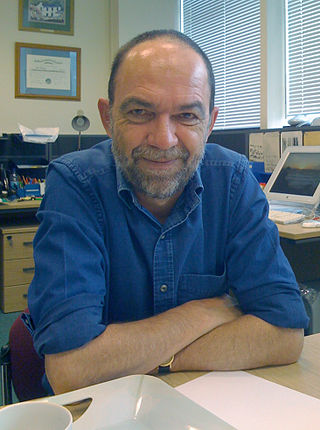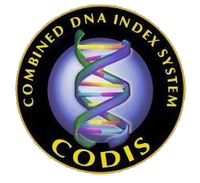Related Research Articles
A microsatellite is a tract of repetitive DNA in which certain DNA motifs are repeated, typically 5–50 times. Microsatellites occur at thousands of locations within an organism's genome. They have a higher mutation rate than other areas of DNA leading to high genetic diversity. Microsatellites are often referred to as short tandem repeats (STRs) by forensic geneticists and in genetic genealogy, or as simple sequence repeats (SSRs) by plant geneticists.

DNA profiling is the process of determining an individual's deoxyribonucleic acid (DNA) characteristics. DNA analysis intended to identify a species, rather than an individual, is called DNA barcoding.

Sir Alec John Jeffreys, is a British geneticist known for developing techniques for genetic fingerprinting and DNA profiling which are now used worldwide in forensic science to assist police detective work and to resolve paternity and immigration disputes. He is Professor of Genetics at the University of Leicester, and became an honorary freeman of the City of Leicester on 26 November 1992. In 1994, he was knighted for services to genetics.

Forensic science, also known as criminalistics, is the application of science principles and methods to support legal decision-making in matters of criminal and civil law.
DNA paternity testing is the use of DNA profiles to determine whether an individual is the biological parent of another individual. Paternity testing can be especially important when the rights and duties of the father are in issue and a child's paternity is in doubt. Tests can also determine the likelihood of someone being a biological grandparent. Though genetic testing is the most reliable standard, older methods also exist, including ABO blood group typing, analysis of various other proteins and enzymes, or using human leukocyte antigen antigens. The current techniques for paternity testing are using polymerase chain reaction (PCR) and restriction fragment length polymorphism (RFLP). Paternity testing can now also be performed while the woman is still pregnant from a blood draw.
Genetic genealogy is the use of genealogical DNA tests, i.e., DNA profiling and DNA testing, in combination with traditional genealogical methods, to infer genetic relationships between individuals. This application of genetics came to be used by family historians in the 21st century, as DNA tests became affordable. The tests have been promoted by amateur groups, such as surname study groups or regional genealogical groups, as well as research projects such as the Genographic Project.
Forensic identification is the application of forensic science, or "forensics", and technology to identify specific objects from the trace evidence they leave, often at a crime scene or the scene of an accident. Forensic means "for the courts".
A genealogical DNA test is a DNA-based genetic test used in genetic genealogy that looks at specific locations of a person's genome in order to find or verify ancestral genealogical relationships, or to estimate the ethnic mixture of an individual. Since different testing companies use different ethnic reference groups and different matching algorithms, ethnicity estimates for an individual vary between tests, sometimes dramatically.
A Y-STR is a short tandem repeat (STR) on the Y-chromosome. Y-STRs are often used in forensics, paternity, and genealogical DNA testing. Y-STRs are taken specifically from the male Y chromosome. These Y-STRs provide a weaker analysis than autosomal STRs because the Y chromosome is only found in males, which are only passed down by the father, making the Y chromosome in any paternal line practically identical. This causes a significantly smaller amount of distinction between Y-STR samples. Autosomal STRs provide a much stronger analytical power because of the random matching that occurs between pairs of chromosomes during the zygote-making process.

Forensic biology involves the application of biological principles and techniques within the context of law enforcement investigations.

Shorttandemrepeat (STR) analysis is a common molecular biology method used to compare allele repeats at specific loci in DNA between two or more samples. A short tandem repeat is a microsatellite with repeat units that are 2 to 7 base pairs in length, with the number of repeats varying among individuals, making STRs effective for human identification purposes. This method differs from restriction fragment length polymorphism analysis (RFLP) since STR analysis does not cut the DNA with restriction enzymes. Instead, polymerase chain reaction (PCR) is employed to discover the lengths of the short tandem repeats based on the length of the PCR product.

FamilyTreeDNA is a division of Gene by Gene, a commercial genetic testing company based in Houston, Texas. FamilyTreeDNA offers analysis of autosomal DNA, Y-DNA, and mitochondrial DNA to individuals for genealogical purpose. With a database of more than two million records, it is the most popular company worldwide for Y-DNA and mitochondrial DNA, and the fourth most popular for autosomal DNA. In Europe, it is the most common also for autosomal DNA. FamilyTreeDNA as a division of Gene by Gene were acquired by MYDNA, Inc., an Australian company, in January 2021.
A DNA database or DNA databank is a database of DNA profiles which can be used in the analysis of genetic diseases, genetic fingerprinting for criminology, or genetic genealogy. DNA databases may be public or private, the largest ones being national DNA databases.

DNAPrint Genomics was a genetics company with a wide range of products related to genetic profiling. They were the first company to introduce forensic and consumer genomics products, which were developed immediately upon the publication of the first complete draft of the human genome in the early 2000s. They researched, developed, and marketed the first ever consumer genomics product, based on "Ancestry Informative Markers" which they used to correctly identify the BioGeographical Ancestry (BGA) of a human based on a sample of their DNA. They also researched, developed and marketed the first ever forensic genomics product - DNAWITNESS - which was used to create a physical profile of donors of crime scene DNA. The company reached a peak of roughly $3M/year revenues but ceased operations in February 2009.
In paternity testing, Paternity Index (PI) is a calculated value generated for a single genetic marker or locus and is associated with the statistical strength or weight of that locus in favor of or against parentage given the phenotypes of the tested participants and the inheritance scenario. Phenotype typically refers to physical characteristics such as body plan, color, behavior, etc. in organisms. However, the term used in the area of DNA paternity testing refers to what is observed directly in the laboratory. Laboratories involved in parentage testing and other fields of human identity employ genetic testing panels that contain a battery of loci each of which is selected due to extensive allelic variations within and between populations. These genetic variations are not assumed to bestow physical and/or behavioral attributes to the person carrying the allelic arrangement(s) and therefore are not subject to selective pressure and follow Hardy Weinberg inheritance patterns.

The Combined DNA Index System (CODIS) is the United States national DNA database created and maintained by the Federal Bureau of Investigation. CODIS consists of three levels of information; Local DNA Index Systems (LDIS) where DNA profiles originate, State DNA Index Systems (SDIS) which allows for laboratories within states to share information, and the National DNA Index System (NDIS) which allows states to compare DNA information with one another.

The International Society for Forensic Genetics – ISFG is an international non-profit scientific society founded in 1968. The main goal of the society is to advance the field of forensic genetics, also termed DNA profiling, through dissemination of scientific results and opinions, communication amongst scientists and education. The bi-annual international ISFG congresses, international workshops and seminars, the society’s scientific journal, and the scientific recommendations on current topics all work towards this goal. The society’s website contains up to date information on all activities.

DNA profiling is the determination of a DNA profile for legal and investigative purposes. DNA analysis methods have changed countless times over the years as technology changes and allows for more information to be determined with less starting material. Modern DNA analysis is based on the statistical calculation of the rarity of the produced profile within a population.

The International Ink Library and its Digital Ink Library are an FBI forensic database of inks. It is used to identify writing instruments, makes, models, ink types, and document authenticity. It contains over 15,000 samples of pen, marker, and printer inks dating from the 1920s. As part of the FBI Questioned Documents Branch, it is used to investigate criminal and terrorist cases, fraudulent documents, forgeries, checks, money orders, and threats to persons. It uses high-performance thin-layer chromatography, electrophoresis, ultraviolet spectra, electrospray ionization and mass spectrometry. It also analyzes chemical date tags expressly inserted by ink manufacturers. The database originated in the 1960s from the collection of Antonio Cantu, former Chief Forensic Chemist at the Secret Service, which dedicated the lab in his honor.
References
- ↑ ISFG Executive Committee
- 1 2 "John Butler".
- ↑ Gershon, Diane (13 May 1999). "Funding brings high-risk technologies to the marketplace". No. 399, 182. Nature. Retrieved 27 March 2021.
- ↑ Butler, J. M.; Li, J.; Shaler, T. A.; Monforte, J. A.; Becker, C. H. (1998). "Reliable genotyping of short tandem repeat loci without an allelic ladder using time-of-flight mass spectrometry". International Journal of Legal Medicine. 112 (1): 45–49. doi:10.1007/s004140050197. ISSN 0937-9827. PMID 9932742. S2CID 13672044.
- ↑ "National Commission on Forensic Science". United States Department of Justice. 20 August 2014. Retrieved 27 March 2021.
- ↑ "National Commission on Forensic Science: Reflecting Back - Looking Toward the Future". The United States Department of Justice. NIST. Retrieved 27 March 2021.
- ↑ Butler, J.M. (2001). Forensic DNA Typing: Biology and Technology behind STR Markers. London: Academic Press. p. 335. ISBN 978-0121479510.
- ↑ Butler, J.M. (2005). Forensic DNA Typing: Biology, Technology, and Genetics of STR Markers (2nd ed.). New York: Elsevier Academic Press. p. 688. ISBN 978-0121479527.
- ↑ Butler, J.M. (2010). Fundamentals of Forensic DNA Typing. San Diego: Elsevier Academic Press. p. 520. ISBN 978-0123749994.
- ↑ Butler, J.M. (2012). Advanced Topics in Forensic DNA Typing: Methodology. San Diego: Elsevier Academic Press. p. 704. ISBN 978-0123745132.
- ↑ Butler, J.M. (2015). Advanced Topics in Forensic DNA Typing: Interpretation. San Diego: Elsevier Academic Press. p. 608. ISBN 978-0124052130.
- ↑ Writing the books on forensic DNA: Dr. John Butler on YouTube
- ↑ ISFG Scientific Prize
- ↑ "Committees".
- ↑ https://1ecb9588-ea6f-4feb-971a-73265dbf079c.filesusr.com/ugd/4344b0_9a5b02ceb7b94880ae7450cb07afefad.pdf Current list of SWGDAM Committee members, last access 27 March 2021
- ↑ https://www.fsigenetics.com/content/edboard last access 27 March 2021
- ↑ https://onlinelibrary.wiley.com/page/journal/15564029/homepage/editorialboard.html last access 27 March 2021
- ↑ https://www.isfg.org/About/Alumni last access 27 March 2021